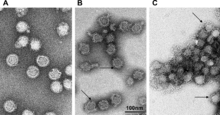Tick-borne encephalitis virus
| Tick-borne meningoencephalitis virus | |
|---|---|
 | |
| TBEV at different pH levels | |
| Virus classification | |
| Group: | Group IV ((+)ssRNA) |
| Family: | Flaviviridae |
| Genus: | Flavivirus |
| Species: | Tick-borne meningoencephalitis virus |
Tick-borne encephalitis virus (TBEV) is the virus associated with tick-borne encephalitis.
Taxonomy
TBEV is a member of the genus Flavivirus. Other close relatives include Omsk hemorrhagic fever virus, Kyasanur forest disease virus, Alkhurma virus, Louping ill virus and the Langat virus.
Subtypes
TBEV has three subtypes:
- Western European subtype (formerly Central European encephalitis virus, CEEV; principal tick vector: Ixodes ricinus);
- Siberian subtype (formerly West Siberian virus; principal tick vector: Ixodes persulcatus);
- Far Eastern subtype (formerly Russian Spring Summer encephalitis virus, RSSEV; principal tick vector: Ixodes persulcatus).[1]
The reference strain is the Sofjin strain.[2]
Evolution
The ancestor of the extant strains appears to have separated into several clades approximately 2750 years ago.[3] The Siberian and Far Eastern subtypes diverged about 2250 years ago.
A second analysis suggests an earlier date of evolution (3300 years ago) with a rapid increase in the number of strains starting ~300 years ago.[4]
This virus has been transmitted at least three times into Japan between 260–430 years ago.[5][6]
The strains circulating in Latvia appear to have originated from both Russia and Western Europe[7] while those in Estonia appear to have originated in Russia.[8] The Lithuanian strains appear to be related to those from Western Europe.[9]
References
- ↑ Goodman, Jesse L.; Dennis, David T. & Sonenshine, Daniel E. (2005). "Tick-Borne Encephalitis". Tick-Borne Diseases of Humans. Washington, DC: ASM Press. p. 151. ISBN 1-55581-238-4.
- ↑ Kovalev SY, Mukhacheva TA, Kokorev VS, Belyaeva IV (April 2012). "Tick-borne encephalitis virus: reference strain Sofjin and problem of its authenticity". Virus Genes. 44 (2): 217–24. doi:10.1007/s11262-011-0690-9. PMID 22095094.
- ↑ Subbotina EL, Loktev VB (2012). "Molecular evolution of the tick-borne encephalitis and Powassan viruses". Mol. Biol. 46 (1): 75–84. doi:10.1134/S0026893311060148. PMID 22642104.
- ↑ Uzcátegui NY, Sironen T, Golovljova I, et al. (April 2012). "Rate of evolution and molecular epidemiology of tick-borne encephalitis virus in Europe, including two isolations from the same focus 44 years apart". J. Gen. Virol. 93 (Pt 4): 786–96. doi:10.1099/vir.0.035766-0. PMID 22205716.
- ↑ Suzuki Y (June 2007). "Multiple transmissions of tick-borne encephalitis virus between Japan and Russia". Genes Genet. Syst. 82 (3): 187–95. doi:10.1266/ggs.82.187. PMID 17660689.
- ↑ Takashima I, Hayasaka D, Goto A, Kariwa H, Mizutani T (February 2001). "Epidemiology of tick-borne encephalitis (TBE) and phylogenetic analysis of TBE viruses in Japan and Far Eastern Russia". Jpn. J. Infect. Dis. 54 (1): 1–11. PMID 11326122.
- ↑ Lundkvist k; Vene S; Golovljova I; et al. (December 2001). "Characterization of tick-borne encephalitis virus from Latvia: evidence for co-circulation of three distinct subtypes". J. Med. Virol. 65 (4): 730–5. doi:10.1002/jmv.2097. PMID 11745938.
- ↑ Golovljova I, Vene S, Sjölander KB, Vasilenko V, Plyusnin A, Lundkvist A (December 2004). "Characterization of tick-borne encephalitis virus from Estonia". J. Med. Virol. 74 (4): 580–8. doi:10.1002/jmv.20224. PMID 15484275.
- ↑ Mickiené A, Vene S, Golovljova I, et al. (December 2001). "Tick-borne encephalitis virus in Lithuania". Eur. J. Clin. Microbiol. Infect. Dis. 20 (12): 886–8. doi:10.1007/s10096-001-0637-5. PMID 11837641.
External links
- Encephalitis Viruses, Tick-Borne at the US National Library of Medicine Medical Subject Headings (MeSH)